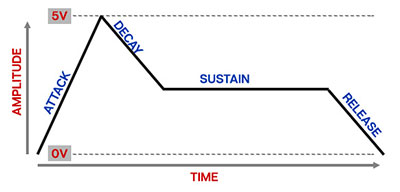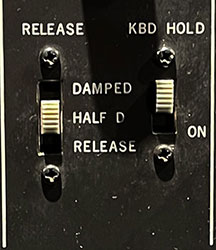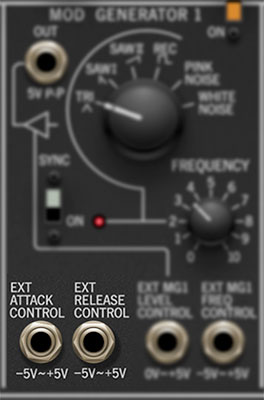
The envelope generators accurately replicate the PS-3300's envelopes, with a couple of minor alterations, which we'll explain. The original PS-3300 attack and decay time constants are insanely long, and they're accurately recreated here.
If you're not familiar with the operation of envelope generators, here's an overview of a standard ADSR-style envelope generator:

When a gate voltage is sent to the envelope generator, it outputs a voltage that changes dynamically according to the settings of its four stages.
The Attack stage defines how long it takes for the output voltage to rise from 0 to 5 volts. Once the attack stage reaches 5V, it moves to the Decay phase, which defines how long it takes to fall from 5V to the setting of the Sustain phase. Unlike the Attack, Decay, and Release phases, each of which define a time, Sustain simply sets the held voltage level following the Attack and Decay phases - this usually equates to the envelope output level while holding down a key on a keyboard controller. Finally, the Release knob defines the the length of time it takes for the voltage to fall back to 0V when the gate input voltage is removed (typically when you let go of a key).
Controls
Attack Time - Defines the length of time for voltage to rise from 0V to 5V when the gate voltage is applied. The maximum Attack time is over 88 seconds (you read that right!).
Decay Time- Defines the length of time for voltage to fall from the attack stage 5V peak to sustain stage setting. The maximum Decay time is over 60 seconds.
Sustain Level- Following the decay stage, this sets the voltage level held until the key is released.
Release Time- Defines the length of time for voltage to fall from 5V to 0V when a key is released.
What We Changed and Why We Did It... get your geek on!
If you look at the panel of an original PS-3300, you'll notice that instead of a release knob, there are two slide switches, Release and Kbd Hold. Here's how they worked:

Release Switch
The Release switch has three positions, Damped, Half D (Damped), and Release. Damped instantly cuts off notes upon release like an organ; Half Damped releases notes at a preset time constant, and Release is the weirdest, with note release times (somewhat) proportional to the Decay Time setting. We originally implemented Cherry PS-3300 with the three-position switch just like the original, but honestly, we found it really hard to use in Release position, and in plain English, it didn't do anything that couldn't be done better with a conventional release knob. We suspect these quirky switched release modes were implemented as a cost-cutting measure in order to save parts count (remember there are 144 envelope generators in the original PS-3300!).
Keyboard Hold
The Kbd Hold switch is one of the oddest and most unique features we've seen on an analog synth. It allows the amplitude of certain notes to be held in a frozen state while playing other has no effect on the frozen notes. Unfortunately, it's almost comically un-inuitive to enable this function on the original - you turn the Kbd Hold switch on, dial the Attack knob up to a setting of 7 or more, play the notes you desire to hold, then dial the Attack knob down to somewhere around 3, and the notes will hold. Meanwhile, any new notes played will articulate normally (i.e. they won't be held).
We made the decision to jettison the hold feature for two reason; 1) it's finicky to set up on the real instrument, 2) it would be even more finicky to set up with a mouse on a screen, and 3) we needed the UI screen real estate to add a conventional Release knob.
Envelope Mod CV Jacks

These jacks are located at the bottom left of the Mod Generator 1 section.
Ext Attack Control jack- Allows a CV to control Envelope Mod Attack time. This is a bipolar input that accepts CV's from -5V to +5V. Negative CV's will lengthen attack duration; positive CV's will shorten attack duration (play harder = faster attack).
Ext Release Control jack- Allows a CV to control Envelope Mod Release time. This is a bipolar input that accepts CV's from -5V to +5V. Negative CV's will shorten release duration; positive CV's will lengthen release duration.